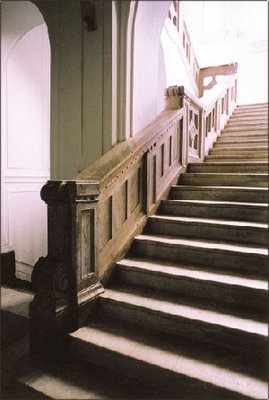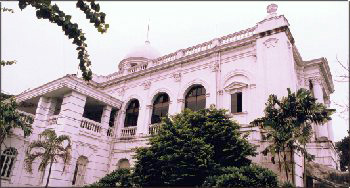
Built for British Governor in 1904 (Old High Court)

West view of Old High Court

Staircase

View from stairway


Portion of Entrance Gate (south east)

Supreme court (inside)

High Court & Supreme Court Complex

Supreme Court building: front view
The white coloured two-storey elegant building, crowned by a dome resting on a ring of columns, in the lush green of Ramna, opposite to Curzon Hall in Kazi Nazrul Islam Avenue is popularly known as the ‘Old High Court Building’.
Approached through a triple-arched gateway in the south, this magnificent edifice stands at the centre of an extensive area originally designed to be the official residence of the Governor of the new province of ‘East Bengal when Assam’ created in 1905. The province (annulled in 1912) was created for improvement in the administration of the people of riverine areas handicapped by difficulty of communication, neglect and stagnant condition. With the creation of new province, the development and architectural trend saw a new turn, and quite a number of notable buildings, a blend of Mughal and European style, were erected in Dhaka.
During first phase of construction, the building was considered not befitting for the Governor's residence. Hence, the building was used as an office for sometime and then given to a college (Dhaka college).
After partition of India in 1947, this building became the seat of High Court of East Pakistan, and its rear wing, an office for Defense Ministry.
A new building for High Court was erected in the north during 60's and High Court moved there. Old building was given to the Defense Ministry. After independence of Bangladesh, additional expansion was taken up in the new High Court premises to accommodate Supreme Court and Bar Library.
Approached through a triple-arched gateway in the south, this magnificent edifice stands at the centre of an extensive area originally designed to be the official residence of the Governor of the new province of ‘East Bengal when Assam’ created in 1905. The province (annulled in 1912) was created for improvement in the administration of the people of riverine areas handicapped by difficulty of communication, neglect and stagnant condition. With the creation of new province, the development and architectural trend saw a new turn, and quite a number of notable buildings, a blend of Mughal and European style, were erected in Dhaka.
During first phase of construction, the building was considered not befitting for the Governor's residence. Hence, the building was used as an office for sometime and then given to a college (Dhaka college).
After partition of India in 1947, this building became the seat of High Court of East Pakistan, and its rear wing, an office for Defense Ministry.
A new building for High Court was erected in the north during 60's and High Court moved there. Old building was given to the Defense Ministry. After independence of Bangladesh, additional expansion was taken up in the new High Court premises to accommodate Supreme Court and Bar Library.
The premise of the High Court bears a mausoleum between Old and new High court building. According to some, it is the tomb of Subader Islam Khan Chishti, the founder of Dhaka, as the mausoleum was once known as the Chishty Behesty's Mazaar.

1 comment:
Its like you read my mind! You appear to know a
lot about this, like you wrote the book in it or something.
I think that you can do with a few pics to drive the message home a
little bit, but instead of that, this is magnificent blog.
An excellent read. I'll definitely be back.
Here is my web blog: diet that works
Post a Comment